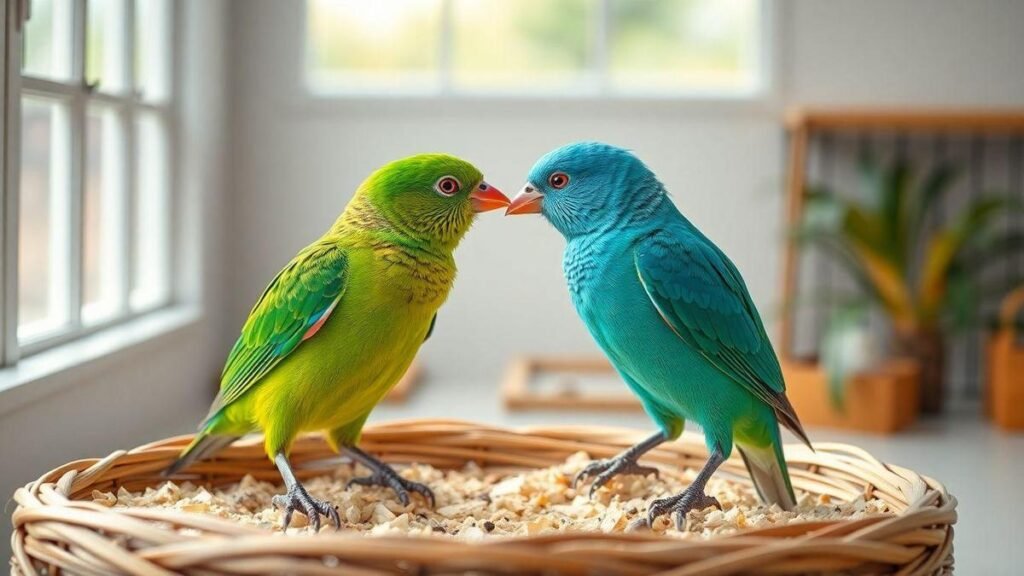Como criar periquitos em ambientes fechados e socialização
I wrote this guide to share what I do for my budgies. I focus on the basic needs — a safe diet, clean water, good light, and steady temperature. I choose a calm, ventilated spot and set up the right cage, mixed perches, and engaging toys for enrichment. My simple daily routine covers feeding, play, rest, short training to build trust, and a quick health check before playtime. I introduce new birds slowly to keep the group calm. Use the phrase Como criar periquitos em ambientes fechados e socialização as your roadmap: small steps, steady routine, gentle patience.
For a general reference, I follow principles from a basic pet care guide that emphasizes consistency and safety.
Key takeaway
- Sit near your budgie and talk softly every day.
- Offer treats by hand to build trust.
- Let the budgie explore a safe room with you present.
- Teach simple words and praise gently to bond.
- Keep a calm, consistent routine so the budgie feels safe.
How I start: cover the basics for Como criar periquitos em ambientes fechados e socialização
I treat each basic need like a brick in a small house — if one brick is weak, the house feels unsafe. My goal: a calm, happy bird that trusts me. I keep steps simple and use small routines every day.
Diet, water, light and temperature
I watch four things first: diet, water, light, and temperature — each affects health and mood. I feed fresh food, swap water daily, provide gentle light and stable warmth. For keeping bowls and the cage hygienic, I follow tips from keeping your pet’s environment clean and comfortable.
| Need | What I do | Quick tip |
|---|---|---|
| Diet | Fresh seed mix fresh veggies several times a week | Start with a tablespoon of greens per bird |
| Water | Change daily; clean bowl weekly | Use plain tap water (filter if needed) |
| Light | 10–12 hours of light, dim at night | Use natural light when possible; cover cage at night |
| Temperature | Keep between 18–25°C (64–77°F) | Avoid drafts and direct heat sources |
Small changes work: one budgie gained weight from too many seeds; adding veggies and cutting treats fixed it in days.
Where to place the cage (cuidados com periquitos em apartamento)
Pick a place that feels like a safe harbor. Avoid kitchens, direct drafts, and harsh sun. Eye-level placement helps social time and keeps the bird calm. If you’re arranging a room for your budgie, advice on how to create a pet-friendly indoor space can help you choose a calm spot.
Key points:
- Away from drafts and direct sun
- Soft background noise, not loud music or TV
- Good airflow, but not a direct fan or AC blast
- Easy reach for cleaning and play
When guests visit, move the cage nearer so your bird learns voices and hands — socialization happens slowly, brick by brick. For helping your bird adjust to changes in the household, see guidance on keeping pets calm during household changes.
Starter checklist for healthy indoor budgies
- Clean water daily
- Fresh food and veggies several times a week
- Cage cleaning: spot clean daily, deep clean weekly
- Light routine: consistent day/night cycle
- Safe spot: calm, ventilated, eye-level
- Toys: rotate to avoid boredom
- Short social sessions: a few minutes, several times a day
- Vet check: at first sign of change in behavior or droppings
Cage, perches and brinquedos para periquitos: enrichment setup
I choose perches of different thicknesses and materials to exercise feet: natural branches, wood dowels, and a soft rope perch. Place thicker perches where the bird rests and thinner ones near food and toys.
| Perch type | Why I use it | Placement |
|---|---|---|
| Natural branch | Varied grip, good for nails | Back of cage for resting |
| Wood dowel | Stable, easy to clean | Near food and water |
| Rope perch | Soft, foot comfort | Lower area, not for long rests |
| Sand/flat perch | Nail wear | Occasional use only |
I rotate toys every few days — keep one or two favorites, swap the rest. Rotating toys keeps the bird curious and supports socialization and training. For ideas on introducing new play items, check approaches to introducing toys and enrichment activities.
Foraging toys and safe swings
Favor toys that make the bird work for treats to mimic wild feeding and keep the mind active. Use safe materials (untreated wood, paper, stainless steel) and avoid paint chips or small parts.
| Toy type | Benefit | Example |
|---|---|---|
| Foraging toy | Stimulates problem solving | Cardboard treat box with hidden millet |
| Puzzle feeder | Slower eating, mental work | Small seed-release puzzle |
| Safe swing | Balance and play | Wide plastic swing, check weekly |
| Chew toy | Beak wear and play | Palm leaf chew, shredded as needed |
I once hid a millet spray in a cardboard roll — the bird learned in two days and became calmer and more curious around people. To keep mental activity consistent, I use techniques from simple ways to keep pets mentally stimulated indoors.
Toy maintenance
- Inspect toys for damage daily
- Clean food-contact toys weekly (warm soapy water, rinse well)
- Deep clean cage monthly (remove perches and toys, scrub)
- Replace toys if frayed, cracked, or after months of use
Keep a small box of spare toys and mark each toy with its introduction date to track preferences. When cleaning or rotating items, follow safe routines to avoid accidental hazards described in keeping pets safe during cleaning and chores.
Daily routine that supports socialization (rotina diária)
Short, consistent sessions beat long, frantic ones. I use a 30-minute daily plan that fits busy schedules and keeps the bird’s routine steady. For building a lasting habit that your pet expects, see suggestions on building a daily routine.
Morning, play and quiet periods
- Start with morning feeding and fresh water. Quick checks build trust.
- Offer a short play session near the cage; talk softly and move slowly.
- Midday, create a quiet period (dim lights, partial cover) for 1–2 hours to reduce stress.
These patterns support Como criar periquitos em ambientes fechados e socialização by balancing stimulation and rest.
My 30-minute plan
| Time (min) | Activity | Purpose |
|---|---|---|
| 5 | Feeding & water check | Top up food, fresh water, quick health check |
| 10 | Play / training | Teach one simple cue, offer toys, gentle talking |
| 10 | Quiet / observation | Let the bird rest, observe behavior, reward calm |
| 5 | Short social close | Hand time or perch time outside cage if calm |
Adapt when your bird shows stress or extra energy (add play if vocal; quiet if ruffled). For preparing your bird to spend short periods alone, these approaches complement preparing your pet for indoor alone time.
Training at home: step-by-step trust building (treinamento de periquitos em casa)
I start slow and stay consistent. Short steps, small goals, no rushing.
| Step | Time | Goal |
|---|---|---|
| Sit near cage | 5–10 min | Bird gets used to your presence |
| Offer finger with treat | 1–2 min | Bird touches your finger |
| Allow step-up | 30–60 sec | Bird steps on your hand |
| Move finger out slowly | 10–30 sec | Bird learns to stay on hand |
Important rules: be consistent, use the same tone, and respect the bird’s pace. Watch for stress signs (fluffed feathers, loud squawks) and pause if needed. To encourage calm, confident behavior, tips on helping pets feel safe and confident indoors are useful.
Reward calm behavior and teach simple cues
I reward calm actions with tiny treats and soft praise. Teach three cues:
- “Step up” — step on finger/perch
- “Stay” — calm sitting
- Name call — focus and social comfort
Keep sessions short (3–6 minutes, 2–3x daily); immediate rewards work best. For socializing, introduce new people slowly and ask guests to stay quiet and offer treats.
My positive reinforcement sequence:
- Prepare (treats ready, remove distractions)
- Cue (one clear word or gesture)
- Wait (give a few seconds)
- Reward (within 1–2 seconds)
- End calmly
Journaling each session — one line: what worked — helps see steady progress.
Health checks and spotting stress (sinais de bem-estar em periquitos)
Daily checks are quick but revealing. Watch appetite, droppings, feather condition, and activity. Regular vet oversight is valuable; see notes on routine vet visits for when to escalate concerns.
| Sign | What to look for | Why it matters | Action |
|---|---|---|---|
| Appetite | Eats usual seed/fruit, drinks | Loss of eating = early sign of trouble | Offer favorite food; watch 12–24 hrs; call vet if no improvement |
| Droppings | Color and consistency steady | Changes can mean illness or stress | Note changes; photo for vet if needed |
| Feathers | Smooth, clean, not constantly fluffed | Ruffled/missing feathers signal stress/parasites | Check for mites; separate sick bird if needed |
| Activity | Active at normal times, sings, preens | Lethargy shows low energy or sickness | Keep warm; limit handling; observe closely |
If you see changes, act fast — early vet visits save stress and money. Also monitor for signs of overstimulation and follow recommendations on recognizing and preventing overstimulation.
When to call a vet
Trust your gut. Call fast for:
- Trouble breathing (wheeze, open-mouth breathing, tail bobbing)
- Severe lethargy (fluffed and sleepy many hours)
- Sudden behavior change (hiding, aggression, not stepping up)
- Inability to perch or obvious pain
- Bleeding, seizures, unconsciousness — emergency
If unsure, send the vet a photo or short video — it helps assess urgency.
Quick daily health check before play:
- 10–20 seconds visual: eyes, nose, breathing
- Ask bird to step up (checks balance)
- Peek at droppings dish for color/amount
- Observe a minute of natural behavior (eating, preening, singing)
Note anything off, take a photo, and keep them calm.
Managing group living and introductions (convívio entre periquitos e humanos)
For Como criar periquitos em ambientes fechados e socialização, be calm and slow. I speak softly, move slowly, and watch body language. When bringing new birds into the home, follow progressive steps similar to those in introducing a new pet to your home and other pets.
Introduce new birds slowly
- Start with visual contact (cages side-by-side) for 3–7 days.
- Offer short supervised visits in a neutral space (5–15 minutes).
- Gradually increase interaction time if calm signs appear.
Signs to move forward: eating near the cage, soft vocalizing, mutual preening. Stop and separate if you see screeching, lunging, or feather pulling. Use treats during meetings to build positive association. For helping a bird settle into a new indoor area, also see helping your pet adjust to a new indoor environment.
Separate resources and monitor body language
Provide multiple food bowls, water stations, and perches at different heights. Spread toys so no bird feels crowded. In apartments, limit free-flight hours to supervised times and give one-on-one attention to reduce jealousy.
| Step | Timeframe | What to do | Move forward if | Stop/separate if |
|---|---|---|---|---|
| Visual contact only | 3–7 days | Cages side-by-side; talk calmly | Eating near cage; soft vocalizing | Screeching; aggressive lunges |
| Short supervised visits | 5–15 min daily | Neutral room; treats for both | Perching close; mutual preening | Chasing; feather pulling |
| Increase interaction | 20–60 min | More toys and food together | Shared feeding; calm preening | Repeated fights; injuries |
| Full cohabitation trial | Several hours supervised | Open shared space with exits | Resting close; cooperative feeding | Persistent chasing; wounds |
| Temporary separation | As needed | Return to separate cages; quiet time | Birds calm down | Restart at previous safe step |
Track each session in notes: what went well and what you changed.
Conclusion
Build care like a small house — brick by brick. Solid basics — safe diet, clean water, good light, and steady temperature — support trust, training, and happy social life. Short, regular sessions beat long, frantic ones. Sit near the cage, offer tiny treats, rotate toys, and swap perches so feet and minds stay busy. Introduce new birds slowly (visual contact, short supervised meetings), watch body language, and separate if needed. Quick health checks focus on appetite, droppings, feathers, and activity — call the vet early if concerned. Above all: patience, consistency, and small rewards. Be the steady harbor your budgie returns to.
For more practical guides and related topics, explore the blog’s collection of related posts.
If you want more practical guides on Como criar periquitos em ambientes fechados e socialização, visit https://blogcraelo.com.
Frequently asked questions
- How do I start socializing my indoor budgies?
Move slow and stay calm. Sit near the cage, talk softly, and offer tiny treats. Keep sessions short and gentle. For calming strategies, see tips on setting up a relaxation corner.
- What space do I need for Como criar periquitos em ambientes fechados e socialização?
A quiet, safe room, a roomy cage, and a supervised play area outside it. Ensure varied, clean perches and toys.
- How often should I handle them to build trust?
Daily, in short bursts. Ten to fifteen minutes works well. Consistency and patience matter most.
- How do I teach them to step up and come to me?
Use treats and a finger as a perch. Reward every small win. Never rush or grab.
- What signs show my budgie is stressed or lonely?
Fluffing constantly, silence, feather plucking, or loss of appetite. Add social time or see a vet if needed. For recognizing overstimulation and how to prevent it, review recognition and prevention strategies.
- Where does “Como criar periquitos em ambientes fechados e socialização” fit in all this?
Use it as a guiding phrase: focus on safe indoor care and gradual socialization. The basics plus steady, gentle human contact create confident, social budgies.






